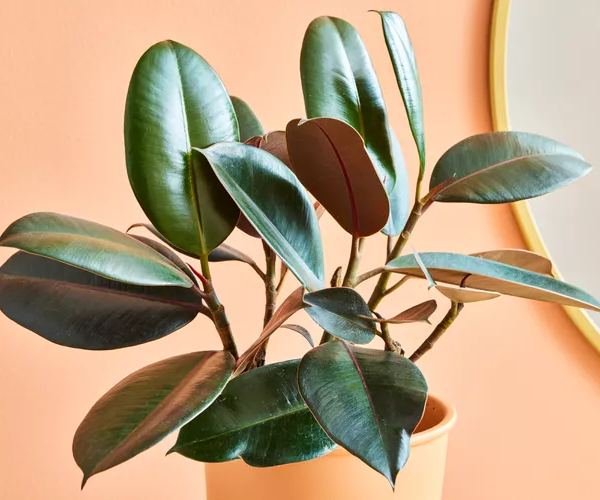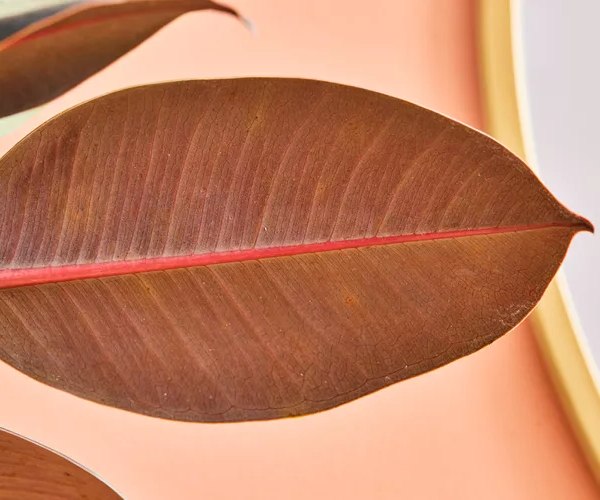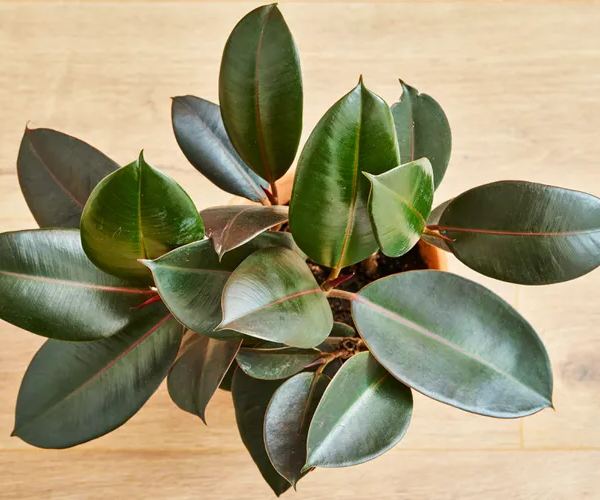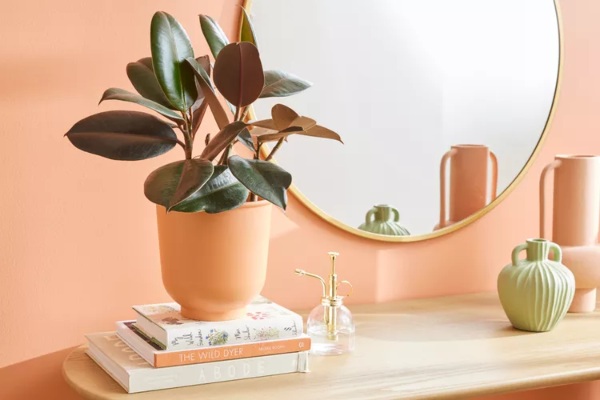If you’re a plant enthusiast, you may have heard about the popular rubber plants which look attractive due to their beautiful foliage and low-maintenance nature. The burgundy rubber plant (ficus elastica ‘burgundy’) is one of its most popular varieties which is characterized by its deep green, almost black leaves with a lusty burgundy tint.
Just like the other varieties of rubber trees, the burgundy rubber plant will grow tall and can even reach 30 feet outdoors and around eighteen feet when grown inside. Normally, they are sold as small potted plants and might take a couple of years to reach their mature height. If you have pets and kids at home, know that this plant is considered toxic if ingested. Its sap can also cause skin irritation in humans.
Plant Attributes
- Common Name: Burgundy rubber plant
- Botanical Name: Ficus elastica ‘burgundy’
- Family: Moraceae
- Plant Type: Tree
- Mature Size: 8 ft. tall, 2-3 ft. wide (indoors); 30-40 ft. tall, 30-40 ft. wide (outdoors)
- Sun Exposure: Full, partial
- Soil Type: Moist but well-drained
- Soil pH: Acidic
- Bloom Time: Spring, summer (rarely flowers indoors)
- Flower Color: Green, white
- Hardiness Zone: 10-12, USDA
- Native Area: Asia
- Toxicity: Toxic to pets
Burgundy Rubber Plant Care
Here are some of the basic needs for growing a burgundy rubber plant:
- Grow the plant in a location that gets full sun to bright, indirect light.
- Plant in a well-draining soil mix.
- Let the soil dry fully between waterings.
- Fertilize regularly during the active growing season to promote healthy growth.
- Clean the large leaves with a moist cloth regularly to keep them dust-free and clean. Dust can deter photosynthesis and cause stunted growth if left to accumulate.
Light
If grown indoors, the burgundy rubber plant thrives with full sun or bright, indirect light. Unlike its variegated types, this plant’s hardy leaves won’t be burnt by sun conditions. However, it will also grow and thrive in bright, indirect light. Know that low light conditions are not suitable for this indoor tree and as a result, they will be leggy and have stunted growth.

Soil
Rubber plants do well in soil that is well-draining yet holds some moisture. If these requirements are fulfilled, these plants aren’t picky about their growing material. Consequently, any potting mix made for houseplants will work as long as it contains perlite, sand, or some materials that support drainage.
Water
As mentioned earlier, rubber plants prefer completely drying out between waterings and do not like overwatering. The rule is that it is better to underwater rubber plants than overwatering them. So, if you don’t know whether your plants need more water or not, just wait. A moisture meter is helpful to determine the amount of water that your plant is getting.
Temperature and Humidity
Average household temperature and humidity levels are best for this tropical plant. Normally, rubber plants do not need any extra heat or humidity to grow and thrive indoors, since it does well in in temperatures between 65 to 85 degrees Fahrenheit (18 to 30 degrees Celsius) and 40 percent to 50 percent humidity. These plants are sensitive to cold temperatures and can not tolerate frost. Protect your plants from cold drafts and keep them away from drafty windows during cold winter temperatures.
Fertilizers
You can feed your burgundy rubber plant with regular fertilization during its active growing period. You can apply a balanced houseplant fertilizer diluted to half-strength every two weeks during the spring and summer to encourage strong, healthy growth.
Pruning
It is not essential to prune a burgundy rubber plant but might be helpful at some point to control its size and growth. Strategic pruning will help you shape your plant’s size, encouraging branching and giving it a fuller appearance.
It is best to prune the plant in the spring or summer when the plant is in its active growing phase. Use a pair of sharp, clean pruning shears, and keep your plant on a sheet or piece of plastic to protect your floors from the latex-like sap that will drip from the cuts. It is necessary to be aware while shaping your cut as every cut will encourage a branch at the nearest node. You can reuse any stem cuttings to propagate new plants.
Also, Read A Complete Guide to Grow and Care for Hens and Chicks Plants
Propagating Burgundy Rubber Plant
You can easily propagate new burgundy rubber plants using stem cuttings. This is a good way to grow new plants to share with your loved ones or repurpose stem cuttings from pruning. Before you start, ensure that you protect your workplace with a sheet or piece of plastic and use gardening gloves to protect your hands from the plant’s sap.

Follow these steps to propagate a burgundy rubber plant.
1. Take one or more stem cuttings from a healthy rubber plant with the help of a pair of sharp, clean pruning shears. Each cutting should have between three to five nodes along the stem, and at least one leaf.
2. Remove the bottom leaves from the plant, exposing the stem and nodes. Remember to leave one or two leaves at the top of each cutting.
3. Dip the cut end of each stem in a rooting hormone. (This is optional)
4. Fill a small pot with a well-draining soil mix and water it thoroughly. It should allow the excess water to drain from the pot.
5. Make a hole in the soil and keep the base of the stem in the hole making sure that the bottom one or two nodes are covered entirely with soil. Gently pat the soil down around the base of the cutting firmly to keep it in its place.
6. Cover the top of each pot with a plastic zip-top to increase humidity and create a greenhouse-like environment. This process will allow roots to sprout during the first couple of weeks.
7. Keep the cuttings in a warm location with bright, indirect light. Avoid direct sunlight until roots are established.
8. Keep the soil moist but not waterlogged and wait until roots have sprouted. Slowly cut back on watering until you are allowing the soil to dry out completely between waterings.
9. Once the roots have sprouted, remove the plastic bags from the plants.
Potting and Repotting Burgundy Rubber Plant
Rubber plants do best when repotted every one or two years or once you see roots growing out of the current container. The best time to repot your plant is in spring or summer since these are the active growing phases.
Look out for signs that your plant needs repotting, like roots growing from the pot’s drainage holes and circling the inside of the pot. Mild popping up of the plant and out of the soil in early spring tells you a lot about how much room it has got in its container to grow.
If your plant is ready to be repotted, follow these simple steps to move it to a new container.
- Remove your burgundy rubber plant from its existing container by gently grabbing the base of the stem and wriggling it out of its pot. If the pot is large, it may help to tip the pot on its side.
- If possible remove old soil as much as possible and loosen the root ball. This may depend on how root-bound the plant is, but try breaking as few roots as possible.
- Choose a new pot that is two to four inches larger in diameter than the current container. Fill the bottom with a fresh and well-draining potting mix.
- Keep the plant in a new container and add more potting soil around the excess space.
- Water the newly planted rubber planted thoroughly, allowing excess water to drain from the pot.
- Keep the plant in its original growing location.
Common Pests and Plant Diseases
The burgundy rubber plant is prone to some common houseplant pests but the most existing one is scale. These sap-sucking insects love the rich sap of this plant and you can also find them on your indoor rubber plant. Check your plant regularly for signs of pests like scale and treat them quickly with an insecticide or neem oil. This plant is susceptible to mealybugs and spider mites.

Burgundy rubber plants are normally disease-free but overwatering can result in root rot. Some common signs of root rot are dropping leaves, soggy stems, and rotting roots. If the damage is extreme, plants may die.
Common Problems With Burgundy Rubber Plant
These plants are usually low-maintenance and free of any big issues but there are chances to run into a few hiccups as you learn how to grow and take of this plant. Most issues are related to watering and light i.e. overwatering and not enough light.
Leggy growth
If your burgundy rubber plant has thin, spindly growth with small leaves then it is clear that the plant needs more light. Leggy growth happens when the plant isn’t receiving enough light and is trying to protect its energy. Usually, the new growth is reaching towards the nearest light source. Keep your plant in a location that gets more light. Bright indirect light or even full sunlight is good. Since the leggy growth can not be reversed, you can simply prune it.
Yellow Leaves
Yellow leaves occur when the plant is overwatered or isn’t getting enough light. Let the soil dry completely between waterings. Give your plant enough light. Keep it right next to, or within a couple feet of a bright west or south-facing window for optimal growth.
FAQs
Q: Can burgundy rubber plants take direct sunlight?
A: Burgundy rubber plants thrive in direct sunlight when grown indoors—just be sure to acclimate your plant to it slowly if it was previously grown in indirect light. Unlike some variegated rubber trees, the dark leaves of the burgundy rubber plant are less prone to leaf burn and thrive when grown in plenty of light.
Q: Do burgundy rubber plants like humidity?
A: Burgundy rubber plants do best in moderate humidity; 40 percent to 50 percent is ideal. This means that average household humidity levels are perfect for burgundy rubber plants. Try to keep your plant away from drafty air vents which could dry out the plant too much.
Q: Should I mist my burgundy rubber plant?
A: Do not mist your burgundy rubber plant to increase humidity around the plant. Misting is relatively ineffective at increasing ambient humidity, and regularly leaving water to sit on the leaves can lead to fungal issues. Try placing a humidifier close to your plant, or putting the pot on top of a pebble tray filled with water if you are worried about humidity.
Also, Read How to Grow and Care for Sesame Plants!
